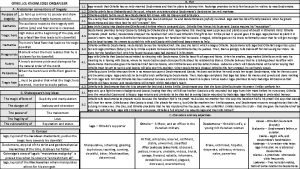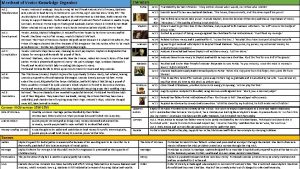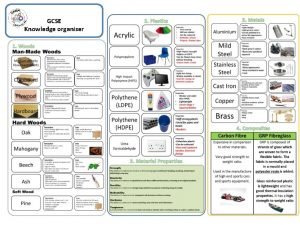ONE GCSE Knowledge Organiser Unit 1 States of


- Slides: 2

ONE GCSE Knowledge Organiser Unit 1 – States of Matter A PARTICLE MODEL Solid Liquid Gas NUSA SCIENCE TWO HEATING AND CHANGES OF STATE High density Low density Retains it’s own shape Assumes shape of container Fixed volume compressible No fixed volume Highly compressible Vibrates Moves randomly and freely THREE DENSITY Density is the Mass per unit Volume boiling Freezing / solidifying condensing Internal energy The energy stored in a system by the particles (the total kinetic energy and potential energy of all the particles). Intermolecular forces (Potential energy) The forces between particles. Applying heat will break the intermolecular forces. Kinetic energy The energy resulting in the movement of the particles. Physical change A change that is reversible. Changes of state are all examples of physical changes. Density: ρ, kg/m 3 Mass: m, kg Volume: V, m 3 melting FIVE SPECIFIC LATENT HEAT FOUR gas Amount of energy supplied the more heat energy transferred to it the greater its temperature increase. Specific heat capacity is the amount of energy required to raise the temperature of 1 Kg of the substance by 10 C’ ΔE = m x c x Δϴ Transferred energy: ΔE, J Mass: m, kg Specific heat capacity: c, J/ kg o. C Temperature change: Δϴ, o. C Temperature / o. C SPECIFIC HEAT CAPACITY Three things affect temperature increase: Mass the more mass, the more energy needed to change its temperature. different materials require different amounts of energy to raise their Material temperature. boiling liquid There is no temperature change at a substances melting or boiling point. Specific latent heat is the HIDDEN HEAT ENERGY that broke the intermolecular bonds for the substance to change state. E=mx. L solid Heat absorbed Energy: E, J Mass: m, kg Specific Latent heat: L, J/kg

GCSE Knowledge Organiser Unit 1 – States of Matter SIX NUSA SCIENCE SEVEN GAS PRESSURE AND TEMPERATURE PURE SUBSTANCES AND MIXTURES Gas pressure Temperatur e A substance which is made up of only one type of atom/ molecule. Pure substances have a fixed melting and boiling point which can be used to distinguish the substance. A mixture consists of two or more different substances, not chemically Mixture joined together. The pressure of a gas is due to the particles colliding with the wall of the container that the gas is held in. The temperature of a gas is related to the average kinetic energy of the particles. The more kinetic energy the higher the temperature. HEAT At room temperature the particles have lower kinetic energy. There are fewer collisions per second and therefore the balloon has a lower pressure. At high temperatures the particles have more kinetic energy therefore there are more collisions per second. The balloon has a higher pressure which may result in the balloon bursting. A pure compound A mixture of elements



